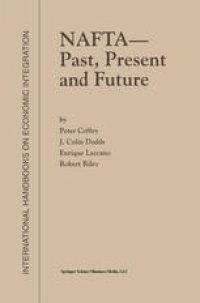
Ebook: NAFTA — Past, Present and Future
- Tags: International Economics, Business/Management Science general
- Series: International Handbooks on Economic Integration 2
- Year: 1999
- Publisher: Springer US
- Edition: 1
- Language: English
- pdf
NAFTA has been described by one expert as being a partial customs union. It is, in any case, a special kind of free trade area because it consists of two highly developed economies and one large third world economy.
In this book, the contributors examine the specific interests of the three member countries, Canada, Mexico, and the United States in the creation of NAFTA. They also assess the influence of this trade area on their economics.
Looking to the future, doubts are expressed about the feasibility of using NAFTA (a hope expressed by the USA) as a stepping stone in the creation of a Free Trade Area of the Americas. Instead, the contributors see the consolidation of MERCOSUR in Latin America and the creation of a new Trans-Atlantic Market - as proposed by Sir Leon Brittan - as more likely developments.
NAFTA has been described by one expert as being a partial customs union. It is, in any case, a special kind of free trade area because it consists of two highly developed economies and one large third world economy.
In this book, the contributors examine the specific interests of the three member countries, Canada, Mexico, and the United States in the creation of NAFTA. They also assess the influence of this trade area on their economics.
Looking to the future, doubts are expressed about the feasibility of using NAFTA (a hope expressed by the USA) as a stepping stone in the creation of a Free Trade Area of the Americas. Instead, the contributors see the consolidation of MERCOSUR in Latin America and the creation of a new Trans-Atlantic Market - as proposed by Sir Leon Brittan - as more likely developments.
NAFTA has been described by one expert as being a partial customs union. It is, in any case, a special kind of free trade area because it consists of two highly developed economies and one large third world economy.
In this book, the contributors examine the specific interests of the three member countries, Canada, Mexico, and the United States in the creation of NAFTA. They also assess the influence of this trade area on their economics.
Looking to the future, doubts are expressed about the feasibility of using NAFTA (a hope expressed by the USA) as a stepping stone in the creation of a Free Trade Area of the Americas. Instead, the contributors see the consolidation of MERCOSUR in Latin America and the creation of a new Trans-Atlantic Market - as proposed by Sir Leon Brittan - as more likely developments.
Content:
Front Matter....Pages i-xxiv
Regional Integration....Pages 1-26
NAFTA and Canada....Pages 27-64
NAFTA in Mexico....Pages 65-112
NAFTA: The US Perspective....Pages 113-168
The Future....Pages 169-177
Back Matter....Pages 179-218
NAFTA has been described by one expert as being a partial customs union. It is, in any case, a special kind of free trade area because it consists of two highly developed economies and one large third world economy.
In this book, the contributors examine the specific interests of the three member countries, Canada, Mexico, and the United States in the creation of NAFTA. They also assess the influence of this trade area on their economics.
Looking to the future, doubts are expressed about the feasibility of using NAFTA (a hope expressed by the USA) as a stepping stone in the creation of a Free Trade Area of the Americas. Instead, the contributors see the consolidation of MERCOSUR in Latin America and the creation of a new Trans-Atlantic Market - as proposed by Sir Leon Brittan - as more likely developments.
Content:
Front Matter....Pages i-xxiv
Regional Integration....Pages 1-26
NAFTA and Canada....Pages 27-64
NAFTA in Mexico....Pages 65-112
NAFTA: The US Perspective....Pages 113-168
The Future....Pages 169-177
Back Matter....Pages 179-218
....